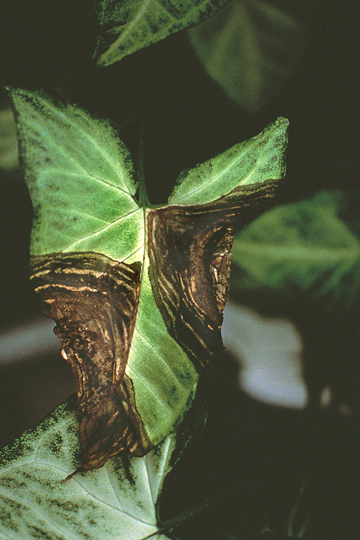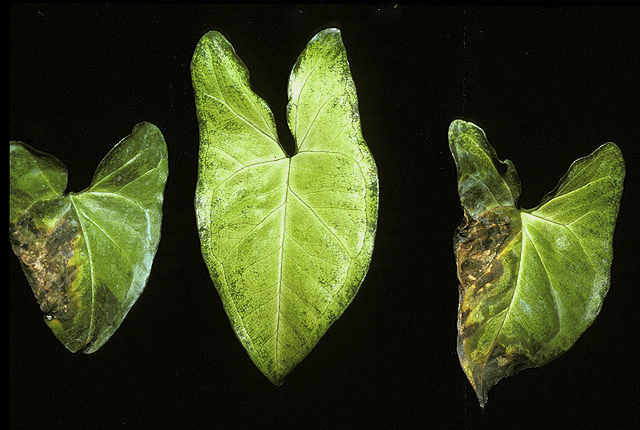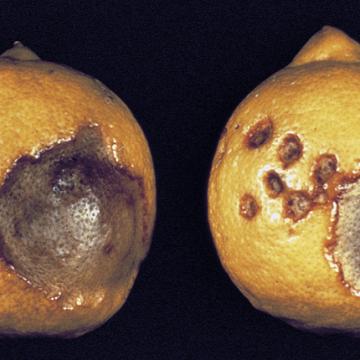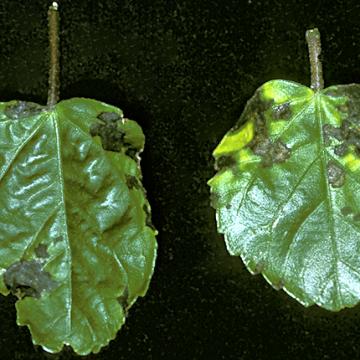DISEASE: Bacterial blast and black pit
HOST: Citrus (Lemon)
The term "black pit" refers to black lesions on fruit, which may be specks or large, sunken pits as seen here. They also may be light tan, later becoming reddish brown to black.

Bacterial blast and black pit | Citrus (Lemon)
DISEASE: Bacterial blast and black pit
HOST: Citrus (Lemon) (Citrus limon)
PATHOGEN: Pseudomonas syringae pv. syringae
SOURCE: J. Menge
DISEASE: Bacterial leaf spot
HOST: Hibiscus
Hibiscus leaves with large, black spots with chlorosis occurring near some lesions.

Bacterial leaf spot | Hibiscus
DISEASE: Bacterial leaf spot
HOST: Hibiscus (Hibiscus sp.)
PATHOGEN: Xanthomonas campestris pv. esculenti
SOURCE: R. Raabe
DISEASE: Bacterial leaf spot
HOST: Nephthytis
Leaf with concentric rings of dark tissues. There has been confusion of the causal agent with Dickeya sp., which also causes mushy leaf spots.

Bacterial leaf spot | Nephthytis
DISEASE: Bacterial leaf spot
HOST: Nephthytis (Syngonium podophyllum)
PATHOGEN: Pectobacterium carotovorum
PATHOGEN SYNONYM: Erwinia carotovora subsp. carotovora
SOURCE: A. Chase
DISEASE: Bacterial leaf spot
HOST: Nephthytis
Water-soaked tissues and large, dark brown necrotic areas at leaf margins. Healthy (center leaf).

Bacterial leaf spot | Nephthytis
DISEASE: Bacterial leaf spot
HOST: Nephthytis (Syngonium podophyllum)
PATHOGEN: Pseudomonas cichorii
SOURCE: S. Thomson
DISEASE: Citrus canker
HOST: Citrus (Lemon)
Lower leaf with raised, corkylike lesions surrounded by dark brown halos, one of the diagnostic symptoms of citrus canker.

Citrus canker | Citrus (Lemon)
DISEASE: Citrus canker
HOST: Citrus (Lemon) (Citrus limon)
PATHOGEN: Xanthomonas citri subsp. citri
PATHOGEN SYNONYM: Xanthomonas citri
SOURCE: T. Gottwald
DISEASE: Syngonium blight
HOST: Nephthytis
Leaf with large, brown to blackish necrotic areas.

Syngonium blight | Nephthytis
DISEASE: Syngonium blight
HOST: Nephthytis (Syngonium podophyllum)
PATHOGEN: Xanthomonas axonopodis pv. dieffenbachiae
PATHOGEN SYNONYM: Xanthomonas campestris pv. dieffenbachiae
SOURCE: R. Raabe







